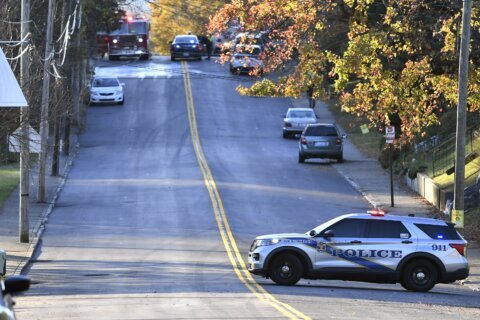DEIR AL-BALAH, Gaza Strip (AP) — Civil defense workers on Friday dug bodies out of collapsed buildings and pulled them off rubble-covered streets, as they collected dozens of Palestinians killed this week by an Israeli assault in a district of Gaza City.
The discovery of the bodies came after Israeli troops reportedly pulled out of parts of the Tal al-Hawa and Sinaah neighborhoods following days of bombardment and fighting there. The Israeli military launched an incursion into the districts earlier this week to fight what it said were Hamas militants who had regrouped.
The grisly scenes of the dead underscored the horrifying cycle nine months into the Gaza war.
After invading nearly every urban area across the tiny territory since October, Israeli forces are now repeatedly re-invading parts as Hamas shifts and maintains capabilities. Palestinians are forced to flee over and over to escape the changing offensives – or to remain in place and face death. Cease-fire negotiations push ahead, nearing but never reaching a deal.
Videos circulating on social media showed civil defense workers wrapping bodies, including several women, in blankets on the rubble-strewn streets of Tal al-Hawa and Sinaah. A hand poked out of the smashed concrete where workers dug into a collapsed building. Other video showed burned-out buildings.
About 60 bodies have been found so far, including entire families who appeared to have been killed by artillery fire and airstrikes as they tried to flee, said Mahmoud Bassal, the director of civil defense in Gaza. Some bodies had been partially devoured by dogs, others burned inside homes and others remained unreachable in rubble, he said.
The director of nearby Al-Ahli Hospital, Fadel Naem, said at least 40 bodies found in the districts had been brought to the facility, though he didn’t have a precise number.
The Israeli military said it could not comment on the discovery of the bodies.
Israel’s assault on the district began after it issued an evacuation order for the area on Monday. In a statement Friday, the military said its troops targeted the abandoned headquarters of the U.N. agency for Palestinian refugees, known as UNRWA, where it said Hamas had set up operations.
UNRWA left the compound in October, early in the war. The military said Friday that troops had battled Hamas and Islamic Jihad fighters in the compound and discovered material for building drones and stashes of weapons. It issued photos of some of the discovered material, though the claims could not be independently confirmed.
On Friday, troops had withdrawn from most of the area, but snipers and drones continued to open fire, said Salem Elrayyes, a resident who fled months ago to the south but spoke to family members still in the neighborhood.
He said that during the days of the offensive, troops set fire to many homes — including that of one of his uncles — and carried out wide-scale arrests, taking people for interrogation inside the UNRWA compound. At least 11 of his relatives were detained, he said.
Two were released after being severely beaten, while the rest are still missing. His family was searching for other relatives still unaccounted for — “some may be detained, and some may have lost communication. Others may be killed,” Elrayyes said.
A day earlier, civil defense workers said they found dozens of bodies in Shijaiyah, another Gaza City district from which Israeli troops withdrew in recent days after a two-week offensive.
Most of the population of Gaza City and the surrounding areas in the north fled earlier in the war. But the U.N. estimates that some 300,000 people remain in the north. With each new assault, people often flee to other parts of the north, since so far Israel has not allowed those who flee south to return to the north.
An airstrike early Friday hit an aid warehouse in Muwasi, part of an Israeli-declared “humanitarian safe zone” covering parts of south and central Gaza, a U.K.-based aid group Al-Khair Foundation said. Imam Qasim Rashid Ahmad, the group’s director in London, said one of its staffers, an engineer, was killed in the strike along with three staffers from other humanitarian groups using the warehouse.
The Israeli military said Husam Mansour, the Al-Khair Foundation member who was killed, was in fact a senior Hamas militant. Israel said he used his position with the humanitarian group to raise money for Hamas.
Israel launched its campaign in Gaza after Hamas’ Oct. 7 attack in which militants stormed into southern Israel, killed some 1,200 people — mostly civilians — and abducted about 250.
Since then, Israeli ground offensives and bombardments have killed more than 38,300 people in Gaza and wounded more than 88,000, according to the territory’s Health Ministry. The ministry does not distinguish between combatants and civilians in its count. More than 80% of Gaza’s 2.3 million people have been driven from their homes, and most are now crowded into squalid tent camps, facing widespread hunger.
Meanwhile in Cairo, U.S., Egyptian and Qatari mediators continued to push to narrow gaps between Israel and Hamas over a proposed deal for a three-phase cease-fire and hostage release plan in Gaza.
The U.S.-backed proposal calls for an initial cease-fire with a limited hostage release and the withdrawal of Israeli troops from populated areas in Gaza. At the same time, the two sides will negotiate the terms of the second phase. Phase two is supposed to bring a full hostage release in return for a permanent cease-fire and complete Israeli withdrawal from Gaza.
But obstacles remain.
Prime Minister Benjamin Netanyahu has said Israel won’t agree to any deal that would prevent it from resuming its military campaign until Hamas is eliminated. On Thursday, he indicated that Israel intends to keep a hold of the Rafah border crossing with Egypt, which would contradict a full withdrawal from Gaza.
Hamas dropped its demand that Israel commit ahead of time to reach a permanent cease-fire. But a Hamas political official told The Associated Press that the group still wants written guarantees from the mediators that negotiations will continue until a permanent cease-fire is reached.
Otherwise, “Netanyahu can stop the negotiations and thus resume the aggression” at any time, said Ahmed Abdul-Hadi, the head of Hamas’ political office in Lebanon.
Abdul-Hadi also said that Hamas does not expect to resume its role as the sole ruling party in Gaza after the war but wants to see a Palestinian government of technocrats.
“We do not want to rule Gaza alone again in the next phase,” he said. Israeli officials have suggested they will demand Hamas’ removal in the talks for the second phase.
Netanyahu is under growing pressure both domestically and internationally. Relatives of hostages are marching to Jerusalem to demand a deal and the release of their loved ones as Israeli politicians, including Defense Minister Yoav Gallant, call for a broad government investigation into the conduct of Israel’s leaders.
A risk of regional escalation remains. Israel’s military said Friday that one of its soldiers was killed in northern Israel, where the Lebanese militant group Hezbollah and Israel continue to trade border fire.
___
Associated Press writers Abby Sewell and Sarah El Deeb in Beirut, Sam Metz in Rabat, Morocco, and Jack Jeffery in Ramallah, West Bank, contributed to this report.
Copyright © 2024 The Associated Press. All rights reserved. This material may not be published, broadcast, written or redistributed.







